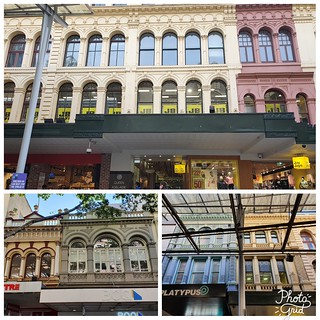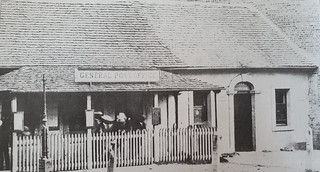The site selected for the Convict Barracks was on a small 16 meter high spur, walking through Queen Street you can still recognise this at the intersection with Albert Street. The spur run roughly from the current Roma Street to Creek Street. The planning of the early settlement had of course also taken the creek as a water supply into account.
Initially a range of slab huts were erected. It wasn’t before Captain Patrick Logan arrived that proper barracks were constructed. This took place between 1827 and 1830. The last slab huts to go where those of the overseers. With these last temporary buildings gone, what would become Queen Street, was now cleared.
Eventually the barracks could accommodate up to 1000 convicts. This became the largest stone building in the settlement. The barracks were situated with the frontage along present-day Queen Street, on the block surrounded by Albert Street, Burnett Lane and George Street. The barracks consisted of a multi-storey stone building with a central archway and a large walled yard to the rear.

The dominant archway of the Prisoners Barracks extended approximately 10 metres through the building from the Queen Street frontage opening into the large walled lumber yard.
Tom Petrie describes the interior. There were different wards for the different classes of prisoners. The beds were simple movable boards on ledges, six by two feet, slightly titled slightly higher on one side with a rounded piece of wood, functioning as a pillow. They were also provided with a double blanket.
In the centre of the barracks was a room functioning as the church. The better prisoners followed the service from here. The iron gang went upstairs and watched from the gallery. There was not always an official clergyman available and in those situations the Commandant, the Doctor and perhaps others did step in to lead the service. The services were quite ecumenical. While the pastor was Anglican they did allow for certain elements of the Roman Catholic rites.
Within the archway itself, strategically situated for all incoming and existing convicts to see, was the flogging triangle. Records indicate that in the period between February and October 1828 alone, over 11,000 lashes were inflicted on 200 convicts; this included 128 sentences of 50 or more lashes. The average in New South Wales was 41 lashes per sentence. The overall death rate during the convict era was around 10%. Flogging would certainly have been a key reason especially in combination with insufficient food, work exhaustion, the extreme climate during the summer month and subsequent tropical diseases.
Three smaller workshop and store rooms – carpentry, tailoring, shoe and uniforms, blacksmiths, wheelwrights – were situated in the yard on the far side of what would become Burnett Lane.
Quite ironically, from 1860 to 1868 the barracks were used as the courthouse as well as for Queensland’s first Parliament. This is what the barracks and neighbouring premises along Queen Street looked like in 1863 on the Ham’s Map of the City of Brisbane. Starting from the corner of George Street and Queen Street – premises/land originally occupied by the so called apartments next to the barracks: Bank of Queensland, Drapers and tailors shop’ Post Office, Town Hall, Four shop: Sadler, tobacconist, draper and chemist, Than we arrive at the barracks proper. In this building we find the following occupants:
- Office of the Colonial Architect
- Judge’s Chamber
- Sherriff’s Office
- Office of the official Assignee (administrator in case of bankruptcies)
- Crown Solicitor’s Office
- Supreme Court House and Offices
- Parliamentary Library
- Legislative Council and Assembly
- The Queensland Guardian Office (welfare of children)
To conclude this block, on the corner of Queens Street and Albert Street was a draper’s shop
The barracks were demolished in 1880 and the vacant land was divided in 15 lots. Commercial redevelopment of the area started in 1881 and included the buildings along Queen Street backing onto Burnett Lane, many of which are still extant (Manwaring Building, Gardams Building, Hardy Brothers Building, Edwards and Chapman Building, Colonial Mutual Chambers, Palings Building, Allan and Stark Building).

Apartments connected to the barracks
Beside the Prisoners’ Barracks, along the Queen Street alignment using the spur towards the river, a row of single-story brick buildings was erected, well before the barracks were completed. The functions of the six apartments of these buildings changed over time including use as the Hansord’s Quarter (In 1829 Hansord was the Deputy Assistant Commissary-General in charge of the Government Store. The apartments were also known as the Officer’s Quarter as some of the apartments were used as such. Furthermore over the years they were used as school room, guard house, Superintendent of Convicts’ residence, goal room, solitary cells, married soldiers’ residences, and a military school.
One of these buildings (Apartment 2) became the first post office. In the picture below it had moved to Apartment 3 and the solitary cells next door (Apartment 4) became the goal of the new settlement. During the convict period the ‘post office’ was at the office of the Commandant. It was the Commandant’s clerk Thomas Whyte – a free man – who became the first postmaster. In 1844 part of the roof had collapsed as white ants had gotten into it and obviously that led to leakages but the government did dot fund any repairs. It was not until four years later that the government finally funded the repairs and Andrew Petrie replaced all of the shingles that had rotten away.

On the other side of the barracks on the corner with Albert Street was a small stockyard for the bullocks.
Convict school
There was no dedicated school building in the convict settlement. Hence the use of these apartments in the convict compound. There was no official school curriculum and none of the teachers during the penal colony period had any proper educational training. There was no oversight from the NSW school inspection. The quality was extremely low and very basic (reading, writing and arithmetic). Nevertheless most of the ones that took up the role of teachers, will no doubt have been given their best within the very poor and difficult circumstances.
Mrs. Esther Roberts became in 1826 the settlement’s first schoolteacher, the wife of Charles Roberts, one of the military staff. She was originally teaching 16 children (8 boys and 8 girls). In 1828 Private John Neill took charge of the 21 boys that were in the school at that time. Esther continued with the girls. The grave of her 2 month old baby was one of the few graves that were transferred from the old settlement’s cemetery to the new cemetery in Toowong.
Commander Logan had ruled that all children under the age of 16 had to attend school. Both the children of female convicts and those of the military families went to the same school. In 1826 there were 16 students attending school.
After Roberts and Neill resigned in 1828 another soldier, Robert Maginnes took over. He was mentioned by the Rev John Vincent as well qualified teacher. At that time there were 32 boys and girls, of which 6 were children of convicts. The Reverend mentioned that the school room was very inadequate and far to small for the hot climate. He also objected to the fact that it was close to the wharf were convicts were working. Indicating that the school now was no longer in one of the apartments in the Convict Compound but in one of the houses in the Commander’s quarter.
Edward Blount succeeded Maginnes in 1831 and he was assisted by his wife, teaching the girls sewing and cultural arts.
In 1836, there were 22 children at the school. Also at that time the teacher was one of the soldiers. They continued till 1833 and by that time the number of pupils was reduced to 31, as many convicts had finished their sentence and relative few new convicts arrived. Next teacher was Sergeant Percy Cleary, he oversaw a slow gradual further decline in the two years he was there. His successor Patrick McDonnel saw the numbers further dwindling to 17. During his time the Female Factory was moved the Eagle Farm. Here a separate school was built which became known as the Convict School. According to the historian J.C. Steele McDonnel and his wife were in charge of the Female Factory in Eagle Farm and Patrick also was running the school there.
The vacancy in town was filled by Lance Corporal Hanley. After some misconduct Patrick and his wife were removed from Eagle Farm and Hanly took over . The misconduct can’t have been that bad as Patrick now became the teacher in town. In late 1837 Henry Cox from Sydney was appointed as the new teacher for Brisbane Town, the school still had 17 pupils. Cox resigned a year later and a Robert McFarlane was mentioned as the new teacher for the 12 children at the school.
A 3rd (unofficial) school arrived with arrival of German missionaries, who settled in Nundah in 1838.
Prison history following the convict era
It is rather ironic that the first new large scale building of the free settlement again was a new goal. It was built on Green Hills (Petrie Terrace) and the building of it was started in 1858. There were two main cell blocks, each one being three stories high and separated into two sections to make a total of four wings. Each wing contained 72 cells arranged back-to-back, and the cells opened onto external balconies with iron railings and external staircases. It separately housed both males and females.
Soon after it opened it became more and more crowded. About 30 prisoners were transferred to an old hulk, called the Proserpine (a converted cattle ship), anchored near the mouth of the Brisbane River, off Lytton. Those imprisoned in the hulk included many major Queensland criminals as well as Established as an overflow prison for the crowded Brisbane Gaol not long after Separation, the hulk, in its years of service, housed many major Queensland criminals as well as rebellious sailors from the mercantile marine.
In 1866, as part of their labours, the prisoners were ferried up and down to St Helena Island, 4 kilometres outside the mouth of the river. They build a new quarantine station on the island. The need for a new prison was more urgent, the quarantine station was scrapped and in 1867 the island was declared ‘a place whereat offenders under order or sentence of hard labour or penal servitude may be detained’.
In 1863, land off Boggo Road was set aside as a government reserve and was finally proclaimed a goal reserve in 1880.

